
by Mahdi Darius Nazemroaya
|
|
Global Research, January 23, 2012
|
|
Strategic Culture Foundation - 2012-01-21
|
Despite
areas of difference and rivalries between Moscow and Tehran, ties
between the two countries, based on common interests, have developed
significantly.
Both Russia and Iran are both major energy exporters, they have deeply seated interests in the South Caucasus. They are both firmly opposed to NATO's missile shield, with a view to preventing the U.S. and E.U. from controlling the energy corridors around the Caspian Sea Basin.
Moscow and Tehran's bilateral ties are also part of a broader and overlapping alliance involving Armenia, Tajikistan, Belarus, Syria, and Venezuela. Yet, above all things, both republics are also two of Washington’s main geo-strategic targets.
The Eurasian Triple Alliance: The Strategic Importance of Iran for Russia and China
Both Russia and Iran are both major energy exporters, they have deeply seated interests in the South Caucasus. They are both firmly opposed to NATO's missile shield, with a view to preventing the U.S. and E.U. from controlling the energy corridors around the Caspian Sea Basin.
Moscow and Tehran's bilateral ties are also part of a broader and overlapping alliance involving Armenia, Tajikistan, Belarus, Syria, and Venezuela. Yet, above all things, both republics are also two of Washington’s main geo-strategic targets.
The Eurasian Triple Alliance: The Strategic Importance of Iran for Russia and China
China,
the Russian Federation, and Iran are widely considered to be allies and
partners. Together the Russian Federation, the People's Republic of
China, and the Islamic Republic of Iran form a strategic barrier
directed against U.S. expansionism. The three countries form a "triple
alliance," which constitutes the core of a Eurasian coalition directed
against U.S. encroachment into Eurasia and its quest for global
hegemony.
While China confronts U.S. encroachment in East Asia and the Pacific, Iran and Russia respectively confront the U.S. led coalition in Southwest Asia and Eastern Europe. All three countries are threatened in Central Asia and are wary of the U.S. and NATO military presence in Afghanistan.
While China confronts U.S. encroachment in East Asia and the Pacific, Iran and Russia respectively confront the U.S. led coalition in Southwest Asia and Eastern Europe. All three countries are threatened in Central Asia and are wary of the U.S. and NATO military presence in Afghanistan.
Iran
can be characterized as a geo-strategic pivot. The geo-political
equation in Eurasia very much hinges on the structure of Iran's
political alliances. Were Iran to become an ally of the United
States, this would seriously hamper or even destabilize Russia and
China. This also pertains to Iran's ethno-cultural, linguistic,
economic, religious, and geo-political links to the Caucasus and Central
Asia.
Moreover,
were the structure of political alliances to shift in favour of the
U.S., Iran could also become the greatest conduit for U.S. influence and
expansion in the Caucasus and Central Asia. This has to do with the
fact that Iran is the gateway to Russia's soft southern underbelly (or
"Near Abroad") in the Caucasus and Central Asia.
In such a scenario, Russia as an energy corridor would be weakened as Washington would "unlock" Iran's potential as a primary energy corridor for the Caspian Sea Basin, implying de facto U.S. geopolitical control over Iranian pipeline routes. In this regard, part of Russia's success as an energy transit route has been due to U.S. efforts to weaken Iran by preventing energy from transiting through Iranian territory.
In such a scenario, Russia as an energy corridor would be weakened as Washington would "unlock" Iran's potential as a primary energy corridor for the Caspian Sea Basin, implying de facto U.S. geopolitical control over Iranian pipeline routes. In this regard, part of Russia's success as an energy transit route has been due to U.S. efforts to weaken Iran by preventing energy from transiting through Iranian territory.
If
Iran were to "change camps" and enter the U.S. sphere of influence,
China's economy and national security would also be held hostage on two
counts. Chinese energy security would be threatened directly because
Iranian energy reserves would no longer be secure and would be subject
to U.S. geo-political interests. Additionally, Central Asia could also
re-orient its orbit should Washington open a direct and enforced conduit
from the open seas via Iran.
Thus,
both Russia and China want a strategic alliance with Iran as a means of
screening them from the geo-political encroachment of the United
States. “Fortress Eurasia” would be left exposed without Iran. This is
why neither Russia nor China could ever accept a war against Iran.
Should Washington transform Iran into a client then Russia and China
would be under threat.
Misreading the Support of China and Russia for U.N. Security Council Sanctions
Misreading the Support of China and Russia for U.N. Security Council Sanctions
There
is a major misreading of past Russian and Chinese support of U.N.
sanctions against Iran. Even though Beijing and Moscow allowed U.N.
Security Council sanctions to be passed against their Iranian ally, they
did it for strategic reasons, namely with a view to keeping Iran out of
Washington's orbit.
In reality, the United States would much rather co-opt Tehran as a satellite or junior partner than take the unnecessary risk and gamble of an all-out war with the Iranians. What Russian and Chinese support for past sanctions did was to allow for the development of a wider rift between Tehran and Washington. In this regard, realpolitik is at work. As American-Iranian tensions broaden, Iranian relations with Russia and China become closer and Iran becomes more and more entrenched in its relationship with Moscow and Beijing.
In reality, the United States would much rather co-opt Tehran as a satellite or junior partner than take the unnecessary risk and gamble of an all-out war with the Iranians. What Russian and Chinese support for past sanctions did was to allow for the development of a wider rift between Tehran and Washington. In this regard, realpolitik is at work. As American-Iranian tensions broaden, Iranian relations with Russia and China become closer and Iran becomes more and more entrenched in its relationship with Moscow and Beijing.
Russia
and China, however, would never support crippling sanctions or any form
of economic embargo that would threaten Iranian national security. This
is why both China and Russia have refused to be coerced by Washington
into joining its new 2012 unilateral sanctions. The Russians have also
warned the European Union to stop being Washington's pawns, because they
are hurting themselves by playing along with the schemes of the United
States. In this regard Russia commented on the impractical and virtually
unworkable E.U. plans for an oil embargo against Iran. Tehran has also
made similar warnings and has dismissed the E.U. oil embargo as a
psychological tactic that is bound to fail.
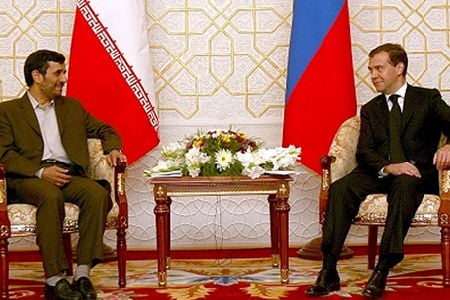
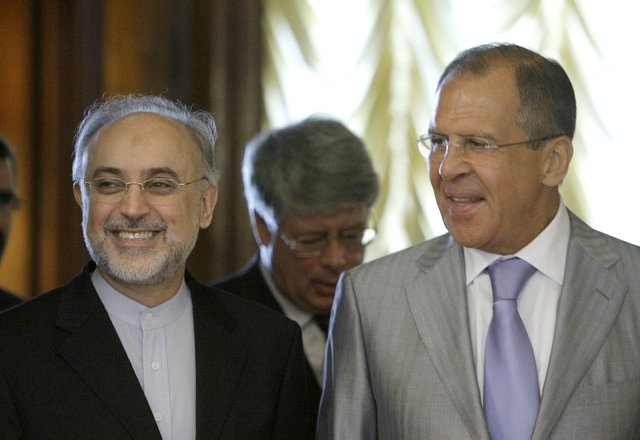 Left
photo: President Mahmoud Ahmadinejad of Iran and President Dmitry A.
Medvedev of Russia during a bilateral meeting in Dushabe, Tajikistan.
Left
photo: President Mahmoud Ahmadinejad of Iran and President Dmitry A.
Medvedev of Russia during a bilateral meeting in Dushabe, Tajikistan.
The bilateral Iranian-Russian meeting was held on the sidelines of a Shanghai Cooperation Organization summit on August 28, 2008.
Right photo: Iranian Foreign Minister Ali Akbar Salehi and Russian Foreign Minister Sergey V. Lavrov together in Moscow discussing Russia’s step-by-step nuclear proposal.
Russo-Iranian Security Cooperation and Strategic Coordination

 Left
photo: President Mahmoud Ahmadinejad of Iran and President Dmitry A.
Medvedev of Russia during a bilateral meeting in Dushabe, Tajikistan.
Left
photo: President Mahmoud Ahmadinejad of Iran and President Dmitry A.
Medvedev of Russia during a bilateral meeting in Dushabe, Tajikistan.The bilateral Iranian-Russian meeting was held on the sidelines of a Shanghai Cooperation Organization summit on August 28, 2008.
Right photo: Iranian Foreign Minister Ali Akbar Salehi and Russian Foreign Minister Sergey V. Lavrov together in Moscow discussing Russia’s step-by-step nuclear proposal.
Russo-Iranian Security Cooperation and Strategic Coordination
In
August 2011, the head of the Supreme National Security Council of Iran,
Secretary-General Saaed (Said) Jalili, and the head of the National
Security Council of the Russian Federation, Secretary Nikolai
Platonovich Patrushev met in Tehran to discuss the Iranian nuclear
energy program as well as bilateral cooperation. Russia wanted to help
Iran rebuff the new wave of accusations by Washington directed against
Iran. Soon after Patrushev and his Russian team arrived in Tehran, the
Iranian Foreign Minister, Ali Akbar Salehi, flew to Moscow.
Both
Jalili and Patrushev met again in September 2011, but this time in
Russia. Jalili went to Moscow first and then crossed the Urals to the
Russian city of Yekaterinburg.
The Iran-Russia Yekaterinburg meeting took place on the sidelines of an international security summit. Moreover, at this venue, it was announced that the highest bodies of national security in Moscow and Tehran would henceforth coordinate by holding regular meetings. A protocol between the two countries was was signed at Yekaterinburg.
During this important gathering, both Jalili and Patrushev held meetings with their Chinese counterpart, Meng Jianzhu. As a result of these meetings, a similar process of bilateral consultation between the national security councils of Iran and China was established. Moreover, the parties also discussed the formation of a supranational security council within the Shanghai Cooperation Council to confront threats directed against Beijing, Tehran, Moscow and their Eurasian allies.
The Iran-Russia Yekaterinburg meeting took place on the sidelines of an international security summit. Moreover, at this venue, it was announced that the highest bodies of national security in Moscow and Tehran would henceforth coordinate by holding regular meetings. A protocol between the two countries was was signed at Yekaterinburg.
During this important gathering, both Jalili and Patrushev held meetings with their Chinese counterpart, Meng Jianzhu. As a result of these meetings, a similar process of bilateral consultation between the national security councils of Iran and China was established. Moreover, the parties also discussed the formation of a supranational security council within the Shanghai Cooperation Council to confront threats directed against Beijing, Tehran, Moscow and their Eurasian allies.
Also
in September 2011, Dmitry Rogozin, the Russian envoy to NATO, announced
that he would be visiting Tehran in the near future to discuss the NATO
missile shield project, which both the Moscow and Tehran oppose.
Reports claiming that Russia, Iran, and China were planning on creating a joint missile shield started to surface. Rogozin, who had warned in August 2011 that Syria and Yemen would be attacked as "stepping stones" in the broader confrontation directed against Tehran, responded by publicly refuting the reports pertaining to the establishment of a joint Sino-Russo-Iranian missile shield project.
Reports claiming that Russia, Iran, and China were planning on creating a joint missile shield started to surface. Rogozin, who had warned in August 2011 that Syria and Yemen would be attacked as "stepping stones" in the broader confrontation directed against Tehran, responded by publicly refuting the reports pertaining to the establishment of a joint Sino-Russo-Iranian missile shield project.
The
following month, in October 2011, Russia and Iran announced that they
would be expanding ties in all fields. Soon after, in November 2011,
Iran and Russia signed a strategic cooperation and partnership agreement
between their highest security bodies covering economics, politics,
security, and intelligence. This was a long anticipated document on
which both Russia and Iran had been working on. The agreement was signed
in Moscow by the Deputy Secretary-General of the Supreme Security
Council of Iran, Ali Bagheri (Baqeri), and the Under-Secretary of the
National Security Council of Russia, Yevgeny Lukyanov.
In
November 2011, the head of the Committee for International Affairs in
the Russian Duma, Konstantin Kosachev, also announced that Russia must
do everything it can to prevent an attack on neighbouring Iran. At the
end of November 2011 it was announced that Dmitry Rogozin would
definitely visit both Tehran and Beijing in 2012, together with a team
of Russian officials to hold strategic discussions on collective
strategies against common threats.
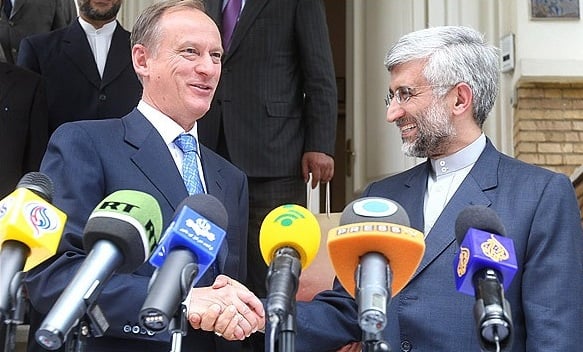
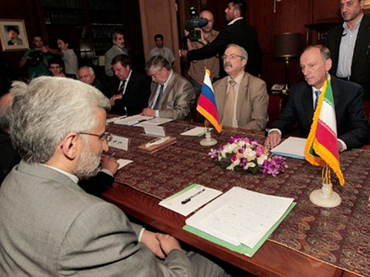 Left
and right photos: Secretary-General Jalili and Secretary Patrushev in
Tehran, Iran holding Iranian-Russian national security talks during
August 2011.
Left
and right photos: Secretary-General Jalili and Secretary Patrushev in
Tehran, Iran holding Iranian-Russian national security talks during
August 2011.
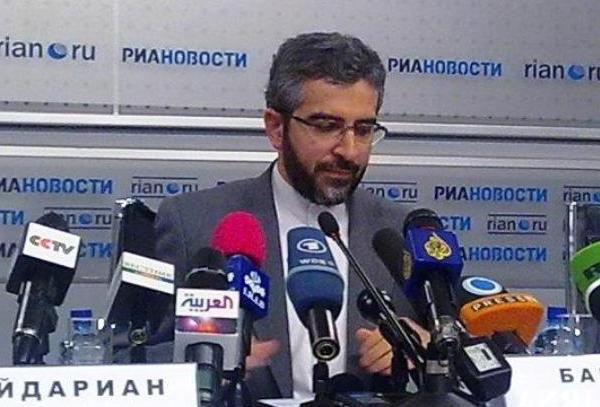
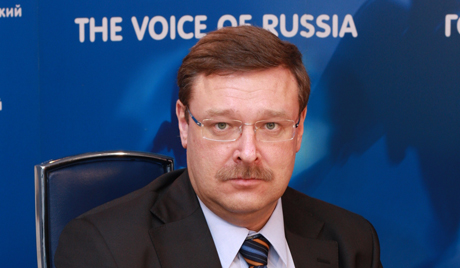 Left
photo: Deputy Secretary-General Ali Bagheri at a press conference in
Moscow, Russia after signing a security pact with Russian officials.
Left
photo: Deputy Secretary-General Ali Bagheri at a press conference in
Moscow, Russia after signing a security pact with Russian officials.
Right photo: Konstantin Kosachev, the Chairperson of the Committee for International Affairs in the Russian Duma.
Russian National Security and Iranian National Security are Attached

 Left
and right photos: Secretary-General Jalili and Secretary Patrushev in
Tehran, Iran holding Iranian-Russian national security talks during
August 2011.
Left
and right photos: Secretary-General Jalili and Secretary Patrushev in
Tehran, Iran holding Iranian-Russian national security talks during
August 2011.
 Left
photo: Deputy Secretary-General Ali Bagheri at a press conference in
Moscow, Russia after signing a security pact with Russian officials.
Left
photo: Deputy Secretary-General Ali Bagheri at a press conference in
Moscow, Russia after signing a security pact with Russian officials.Right photo: Konstantin Kosachev, the Chairperson of the Committee for International Affairs in the Russian Duma.
Russian National Security and Iranian National Security are Attached
On January 12, 2012, Nikolai Patrushev told Interfax
he feared that a major war was imminent and that Tel Aviv was pushing
the U.S. to attack Iran. He dismissed the claims that Iran was secretly
manufacturing nuclear weapons and said that for years the world had
continuously heard that Iran would have an atomic bomb by next week ad
nauseum. His comments were followed by a dire warning from Dmitry
Rogozin.
On
January 13, 2012, Rogozin, who had been appointed deputy prime minister,
declared that any attempted military intervention against Iran would be
a threat to Russia's national security. In other words, an attack on
Tehran is an attack on Moscow. In 2007, Vladimir Putin essentially
mentioned the same thing when he was in Tehran for a Caspian Sea summit,
which resulted in George W. Bush Jr. warning that World War III could
erupt over Iran. Rogozin's statement is merely a declaration of what has
been the position of Russia all along: should Iran fall, Russia would
be in danger.
Iran
is a target of U.S. hostility not just for its vast energy reserves and
natural resources, but because of major geo-strategic considerations
that make it a strategic springboard against Russia and China. The roads
to Moscow and Beijing also go through Tehran, just as the road to
Tehran goes through Damascus, Baghdad, and Beirut. Nor does the U.S.
want to merely control Iranian oil and natural gas for consumption or
economic reasons. Washington wants to put a muzzle around China by
controlling Chinese energy security and wants Iranian energy exports to
be traded in U.S. dollars to insure the continued use of the U.S. dollar
in international transactions.
Moreover,
Iran has been making agreements with several trade partners, including
China and India, whereby business transactions will not be conducted in
euros or U.S. dollars. In January 2012, both Russia and Iran replaced
the U.S. dollar with their national currencies, respectively the Russian
rouble and the Iranian rial, in their bilateral trade. This was an
economic and financial blow to the United States.
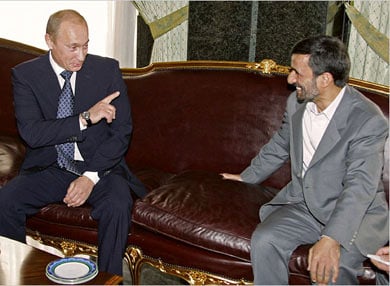
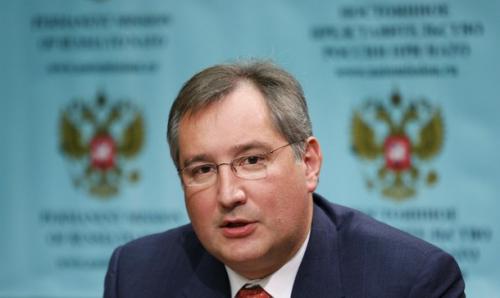
Left photo: Vladimir V. Putin and Mahmoud Ahmadinejad holding talks in Tehran, Iran on the sidelines of a summit of Caspian Sea nations in October 2007.
Right photo: Dmitry O. Rogozin, the departing representative of Russia at NATO Headquarters in Brussels, Belgium.
Syria and the National Security Concerns of Iran and Russia

Left photo: Vladimir V. Putin and Mahmoud Ahmadinejad holding talks in Tehran, Iran on the sidelines of a summit of Caspian Sea nations in October 2007.
Right photo: Dmitry O. Rogozin, the departing representative of Russia at NATO Headquarters in Brussels, Belgium.
Russia
and China with Iran are all staunchly supporting Syria. The diplomatic
and economic siege against Syria is tied to the geo-political stakes to
control Eurasia. The instability in Syria is tied to the objective of
combating Iran and ultimately turning it into a U.S. partner against
Russia and China.
The
cancelled or delayed deployment of thousands of U.S. troops to Israel
for "Austere Challenge 2012" was tied to ratcheting up the pressure
against Syria. On the basis of a Voice of Russia report, segments of the
Russian media erroneously reported that "Austere Challenge 2012" was
going to be held in the Persian Gulf, which was mistakenly picked up by
news outlets in other parts of the world. This helped highlight the
Iranian link at the expense of the Syrian and Lebanese links. The
deployment of U.S. troops was aimed predominately at Syria as a means of
isolating and combating Iran. The "cancelled" or "delayed" Israeli-U.S.
missile exercises most probably envisaged preparations for missile and
rocket attacks not only from Iran, but also from Syria, Lebanon, and the
Palestinian Territories.
Aside
from its naval ports in Syria, Russia does not want to see Syria used
to re-route the energy corridors in the Caspian Basin and the
Mediterranean Basin. If Syria were to fall, these routes would be
re-synchronized to reflect a new geo-political reality. At the expense
of Iran, energy from the Persian Gulf could also be re-routed to the
Mediterranean through both Lebanon and Syria.
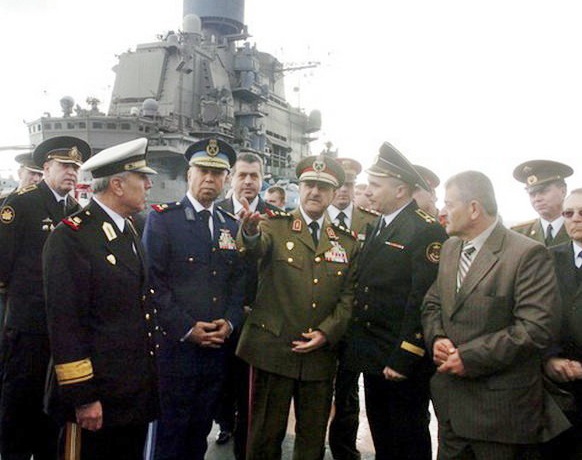
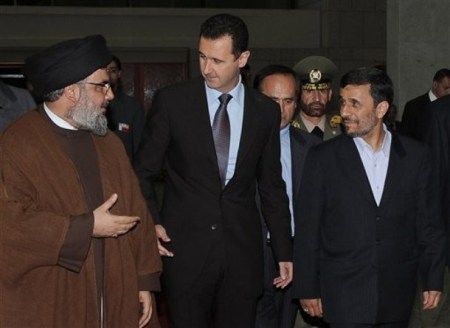
Left photo: Syrian Defence Minister Dawoud (David) Rajha visiting the docked Russian aircraft carrier Admiral Kuznetsov in the Syrian port of Tartus on January 8, 2012.
Right photo: Syrian allies, Secretary-General Hassan Nasrallah of Hezbollah and Mahmoud Ahmadinejad of Iran, join President Bashar Al-Assad for a summit in Damascus, Syria on February 25, 2010.
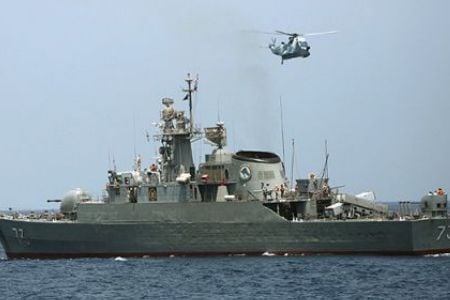

Left photo: The Alvand, one of the two Iranian warships that visited the Syrian port of Lattakia during February 2011.
Right photo: Rear-Admirial Habibollah Sayyari holding a press conference on February 28, 2001 at the Iranian Embassy in Syria about the Iranian naval presence off Syria’s Mediterranean coast. .
http://www.globalresearch.ca/index.php?context=va&aid=28790
Dịch
Bất
chấp những lĩnh vực khác biệt và sự thù địch giữa Mátxcơva và Têhêran,
các quan hệ giữa hai nước, dựa trên những lợi ích chung, đang phát triển
mạnh mẽ. Cả Nga và Iran đều là những nước xuất khẩu năng lượng lớn và
đều có những lợi ích sâu sắc tại Nam Cápcadơ. Cả hai nước đều kiên quyết
phản đối lá chắn tên lửa của NATO tại châu Âu, với tầm nhìn nhằm ngăn
Mỹ và Liên minh châu Âu (EU) kiểm soát các hành lang năng lượng xung
quanh khu vực Lòng chảo Biển Caxpi. Các quan hệ song phương của Mátxcơva
và Têhêran cũng là một phần của liên minh rộng hơn, có liên quan đến
Ácmênia, Tátgikixtan, Bêlarút, Xyri và Vênêxuêla. Nhưng trên hết, cả Nga
và Iran cũng đều là hai mục tiêu địa chiến lược chủ chốt của Mỹ.
Liên minh tay ba Á-Âu: Tầm quan trọng chiến lược của Iran đối với Nga và Trung Quốc
Trung
Quốc, Liên bang Nga và Iran được đông đảo mọi người coi là các đồng
minh và đối tác. Ba nước này đang lập ra một rào cản chiến lược nhằm
trực tiếp chống lại chủ nghĩa bành trướng của Mỹ. Liên minh ba nước này
là nòng cốt của một liên minh Á-Âu để chống lại sự xâm lấn của Mỹ vào
lục địa Á-Âu, cũng như việc thực hiện mục tiêu bá chủ toàn cầu của
Oasinhtơn. Trong khi Trung Quốc phải đối đầu với sự xâm lấn của Mỹ tại
Đông Á và Thái Bình Dương, thì Nga và Iran phải đối đầu với liên minh do
Mỹ lãnh đạo tại Đông Âu và Tây Nam Á. Cả ba nước này đều bị đe dọa tại
Trung Á và quan ngại về sự có mặt của Mỹ và NATO tại Ápganixtan. Iran có
thể được mô tả như một trục địa chiến lược. Phương trình địa chính trị
tại lục địa Á-Âu đang chủ yếu xoay quanh cấu trúc các liên minh chính
trị của Iran . Khả năng Iran có thể trở thành đồng minh của Mỹ sẽ cản
trở hoặc thậm chí gây bất ổn cho Nga và Trung Quốc. Việc này cũng gắn
liền với các mối liên hệ sắc tộc-văn hóa, ngôn ngữ, kinh tế, tôn giáo và
địa chính trị với khu vực Cápcadơ và Trung Á. Hơn nữa, nếu cấu trúc các
liên minh chính trị chuyển sang có lợi cho Mỹ, Iran cũng có thể trở
thành "chất dẫn xuất" lớn nhất cho ảnh hưởng và sự bành trướng của Mỹ
tại Cápcadơ và Trung Á. Thực tế là Iran đang là cửa ngõ dẫn vào khu vực
hiểm yếu dễ bị tấn công của Nga tại Cápcadơ và Trung Á.
Trong
một kịch bản như vậy, vị thế hành lang năng lượng của Nga sẽ bị suy yếu
nếu Mỹ có thể "mở khóa" tiềm năng của Iran như một hành lang năng lượng
chủ chốt cho khu vực lòng chảo Biển Caxpi, ám chỉ đến sự kiểm soát địa
chính trị thực tế của Mỹ đối với các tuyến đường ống dẫn dầu của Iran.
Trong vấn đề này, một phần thành công của Nga như một tuyến quá cảnh
năng lượng là nhờ những nỗ lực của Mỹ nhằm làm suy yếu Iran bằng cách
ngăn việc vận chuyển năng lượng qua lãnh thổ Iran. Nếu Iran "chuyển bên"
và gia nhập trường ảnh hưởng của Mỹ, nền kinh tế và an ninh quốc gia
của Trung Quốc cũng sẽ bị biến thành con tin. An ninh năng lượng của
Trung Quốc sẽ bị đe dọa trực tiếp bởi vì trữ lượng năng lượng của Iran
sẽ không còn được đảm bảo và sẽ bị lệ thuộc vào các lợi ích địa chính
trị của Mỹ. Thêm vào đó, Trung Á cũng sẽ chuyển hướng quỹ đạo. Vì thế,
cả Nga và Trung Quốc đều mong muốn một liên minh chiến lược với Iran như
một biện pháp nhằm tự che chắn khỏi sự xâm lấn địa chính trị của Mỹ.
"Pháo đài Á-Âu" sẽ bị nguy hiểm nếu thiếu Iran . Đó là lý do tại sao cả
Nga lẫn Trung Quốc đều không bao giờ chấp nhận một cuộc chiến tranh
chống lại Iran. Nếu Mỹ có thể biến đổi Iran thành một "đồng minh", thì
Nga và Trung Quốc sẽ bị đe dọa.
Nhầm lẫn về sự ủng hộ của Nga và Trung Quốc đối với các lệnh trừng phạt Iran của Hội Đồng Bảo An Liên Hiệp Quốc
Thế
giới đã nhầm lẫn rất lớn về sự ủng hộ trước đây của Nga và Trung Quốc
đối với các lệnh trừng phạt Iran của Hội Đồng Bảo An Liên Hiệp Quốc. Cho
dù Bắc Kinh và Mátxcơva cho phép các lệnh trừng phạt của Hội Đồng Bảo
An Liên Hiệp Quốc chống lại các đồng minh Iran của họ được thông qua, họ
cũng chỉ làm vậy vì những lý do chiến lược, để giữ cho Iran nằm ngoài
quỹ đạo của Oasinhtơn. Trên thực tế, Mỹ nên kết nạp Iran làm một vệ tinh
hoặc một đối tác cấp thấp hơn là chấp nhận những rủi ro không cần thiết
và mạo hiểm một cuộc chiến tổng lực với Iran. Việc Nga và Trung Quốc
ủng hộ các lệnh trừng phạt trước đây là để cho phép phát triển mâu thuẫn
rộng hơn giữa Têhêran và Oasinhtơn. Khi những căng thẳng Mỹ-Iran tăng
lên, các quan hệ của Iran với Nga và Trung Quốc trở nên gần gũi hơn và
Iran ngày càng bám chặt vào các mối quan hệ với Bắc Kinh và
Mátxcơva. Tuy nhiên, Nga và Trung Quốc sẽ không bao giờ ủng hộ các biện
pháp trừng phạt làm tê liệt hoặc bất kỳ hình thức cấm vận kinh tế nào có
thể đe dọa an ninh quốc gia của Iran. Đó là lý do vì sao cả Trung Quốc
và Nga đều từ chối sự ép buộc của Mỹ phải tham gia các lệnh trừng phạt
đơn phương mới năm 2012 của họ. Nga cũng đã cảnh báo Liên minh châu Âu
(EU) đừng làm "con tốt" của Mỹ, bởi vì EU đang làm hại chính mình khi
hợp tác cùng các kế hoạch của Mỹ. Về vấn đề này, Nga nhận xét rằng các
kế hoạch cấm vận dầu mỏ chống Iran của EU là không thực tế và không khả
thi. Iran cũng đưa ra những cảnh báo tương tự và coi lệnh cấm vận dầu mỏ
của EU chỉ là một chiến thuật tâm lý và sẽ thất bại.
Sự hợp tác an ninh và phối hợp chiến lược Nga-Iran
Vào
tháng 8/2011, người đứng đầu Hội đồng An ninh quốc gia tối cao Iran,
Tổng thư ký Saaed (Said) Jalili, và người đứng đầu Hội đồng An ninh quốc
gia Liên bang Nga Nikolai Platonovich Patrushev đã gặp nhau tại Têhêran
để thảo luận về chương trình năng lượng nguyên tử của Iran, cũng như sự
hợp tác song phương. Nga muốn giúp Iran đẩy lùi làn sóng cáo buộc mới
của Oasinhtơn nhằm vào Iran. Ngay sau khi ông Patrushev và ê kíp của ông
đến Têhêran, Ngoại trưởng Iran Ali Akbar Salehi đã bay tới Mátxcơva. Cả
hai ông Jalili và Patrushev đã gặp lại nhau vào tháng 9/2011, nhưng lần
này ở Nga. Ông Jalili đã tới Mátxcơva trước và sau đó vượt dãy Ural tới
thành phố Yekaterinburg. Hội nghị Yekaterinburg Nga-Iran đã diễn ra bên
lề một hội nghị an ninh quốc tế. Hơn nữa, tại hội nghị này họ đã tuyên
bố rằng hai tổ chức an ninh cấp cao nhất tại Mátxcơva và Têhêran từ nay
sẽ phối hợp bằng cách tổ chức các hội nghị thường xuyên. Hai nước đã ký
một nghị định thư tại Yekaterinburg. Tại hội nghị quan trọng này, cả hai
ông Jalili và Patrushev đều gặp đối tác Trung Quốc là Mạnh Kiến Trụ.
Kết quả của các cuộc gặp này là một tiến trình tư vấn song phương tương
tự giữa các hội đồng an ninh quốc gia Nga và Trung Quốc đã được thiết
lập. Hơn nữa, các bên cũng thảo luận việc thành lập một hội đồng an ninh
siêu quốc gia trong nội bộ Tổ chức Hợp tác Thượng Hải (SCO) để đương
đầu với những nguy cơ nhằm chống lại Bắc Kinh, Mátxcơva, Têhêran và các
đồng minh Á-Âu khác của họ. Cũng trong tháng 9/2011, Dmitry Rogozin, đặc
phái viên của Nga tại NATO, tuyên bố ông sẽ thăm Têhêran trong một
tương lai gần để thảo luận về dự án lá chắn tên lửa NATO mà cả Mátxcơva
và Têhêran đều phản đối. Những thông tin cho rằng Nga , Iran và Trung
Quốc đang có kế hoạch thành lập một lá chắn tên lửa chung đã bắt đầu nổi
lên. Rogozin, người đã cảnh báo từ tháng 8/2011 rằng Xyri và Yêmen sẽ
bị tấn công như những bàn đạp trong cuộc đối đầu lớn hơn nhằm vào Iran,
đã phản ứng bằng cách công khai bác bỏ những tin tức có liên quan đến
việc thành lập một dự án lá chắn tên lửa chung Trung Quốc-Nga-Iran.
Vào
tháng 10/2011, Nga và Iran đã tuyên bố rằng họ sẽ mở rộng quan hệ trong
tất cả các lĩnh vực. Ngay sau đó, vào tháng 11/2011, Iran và Nga đã ký
một hiệp định hợp tác chiến lược và quan hệ đối tác giữa các tổ chức an
ninh cấp cao nhất, có liên quan đến kinh tế, chính trị, an ninh và tình
báo. Hiệp định này là văn kiện được dự đoán từ lâu và được ký tại
Mátxcơva. Vào tháng 11/2011, người đứng đầu Ủy ban các vấn đề quốc tế
thuộc Duma quốc gia (Hạ viện Nga) Konstantin Kosachev đã tuyên bố rằng
Nga phải nỗ lực hết sức để ngăn chặn một cuộc tấn công vào nước láng
giềng Iran. Cuối tháng 11/2011, Nga tuyên bố ông Rogozin sẽ thăm cả
Têhêran và Bắc Kinh trong năm 2012, cùng với một phái đoàn các quan chức
Nga để thảo luận về các chiến lược tập thể chống lại các nguy cơ
chung. Ngày 12/1/2012, ông Patrushev đã nói với hãng thông tấn Interfax
rằng ông quan ngại khả năng xảy ra một cuộc chiến tranh lớn và rằng Ten
Avíp đang thúc đẩy Mỹ tấn công Iran. Ông Patrushev bác bỏ tuyên bố rằng
Iran đang bí mật chế tạo vũ khí hạt nhân và nói rằng trong nhiều năm thế
giới đã liên tục được nghe rằng Iran sẽ có một quả bom nguyên tử vào
tuần tới. Phát biểu của ông được nối tiếp bằng một cảnh báo của ông
Rogozin. Ngày 13/1/2012, ông Rogozin được bổ nhiệm làm Phó Thủ tướng
Nga, tuyên bố rằng bất kỳ âm mưu can thiệp quân sự nào chống lại Iran sẽ
là một nguy cơ đối với an ninh quốc gia của Nga. Nói cách khác, một
cuộc tấn công Têhêran sẽ là một cuộc tấn công vào Mátxcơva. Năm 2007,
Thủ tướng Vladimir Putin đã đề cập điều tương tự khi ông ở Têhêran dự
một hội nghị thượng đỉnh Biển Caxpi, khiến Tổng thống Mỹ hồi đó là
George W. Bush con cảnh báo rằng Chiến tranh thế giới thứ 3 có thể nổ ra
vì Iran. Phát biểu của ông Rogozin chỉ là một tuyên bố quan điểm của
Nga lâu nay: nếu Iran sụp đổ, Nga sẽ gặp nguy hiểm.
Iran
là một mục tiêu của Mỹ không chỉ vì trữ lượng năng lượng và các nguồn
tài nguyên dồi dào của họ, mà do những xem xét địa chiến lược, muốn biến
Iran thành một bàn đạp chiến lược chống lại Nga và Trung Quốc. Những
con đường dẫn tới Mátxcơva và Bắc Kinh phải đi qua Têhêran, cũng giống
con đường tới Têhêran phải đi qua Đamát, Bátđa và Bâyrút. Mỹ cũng không
chỉ muốn kiểm soát dầu khí Iran cho tiêu dùng hoặc các lý do kinh tế.
Oasinhtơn đang mong muốn thiết lập một vành đai xung quanh Trung Quốc
bằng cách kiểm soát an ninh năng lượng của Trung Quốc và mong muốn xuất
khẩu dầu mỏ của Iran sẽ được giao dịch bằng đồng USD để đảm bảo việc
tiếp tục sử dụng đồng USD trong các giao dịch quốc tế. Hơn nữa, Iran
đang soạn thảo một số hiệp định với một số đối tác thương mại, trong đó
có Trung Quốc và Ấn Độ, mà những giao dịch tài chính sẽ không được thực
hiện bằng đồng USD hay euro. Trong tháng 1/2012, cả Nga và Iran đã thay
đồng USD bằng các đồng nội tệ của họ trong thương mại hai chiều. Đây là
một cú đòn tài chính và kinh tế đối với Mỹ.
Xyri và những quan ngại an ninh quốc gia của Nga và Iran
Nga,
Trung Quốc và Iran đều đang kiên định ủng hộ Xyri. Vòng vây ngoại giao
và kinh tế chống lại Xyri có liên quan đến những kế hoạch địa chính trị
nhằm kiểm soát khu vực Âu-Á. Sự bất ổn tại Xyri có liên quan đến mục
tiêu chống lại Iran và cuối cùng biến Iran thành một đối tác của Mỹ để
chống lại Nga và Trung Quốc. Sự triển khai bị hủy bỏ hoặc trì hoãn hàng
nghìn quân Mỹ tại Ixraen cho cuộc tập trận tên lửa "Thách thức khắc khổ
2012" có liên quan đến việc tăng sức ép chống lại Xyri. Trước đó, một số
phương tiện truyền thông Nga đã đưa thông tin sai rằng cuộc tập trận
"Thách thức khắc khổ 2012" được tổ chức tại Vịnh Pécxích. Điều này giúp
nêu bật các mối quan hệ giữa Iran với Xyri và Libăng. Việc triển khai
quân Mỹ chủ yếu nhằm vào Xyri như một phương tiện nhằm cô lập và chống
lại Iran. Việc "trì hoãn" hoặc "hủy bỏ" các cuộc tập trận tên lửa
Ixraen-Mỹ nhiều khả năng là để chuẩn bị chống lại các cuộc tấn công bằng
tên lửa và rốckét không chỉ từ Iran, mà còn từ Xyri, Libăng và các vùng
lãnh thổ Palextin. Ngoài những cảng hải quân tại Xyri, Nga không muốn
thấy Xyri được sử dụng để thay đổi tuyến hành lang năng lượng tại khu
vực Lòng chảo Caxpi và Lòng chảo Địa Trung Hải. Nếu Xyri bị sụp đổ,
những tuyến đường này có thể bị tái đồng bộ hóa để phản ánh một thực tế
địa chính trị mới. Nếu Iran sụp đổ, năng lượng từ Vịnh Pécxích cũng có
thể được đổi tuyến sang Địa Trung Hải thông qua cả Libăng và Xyri./.
Theo Globalresearch (23/1)
Vũ Hiền (gt)












